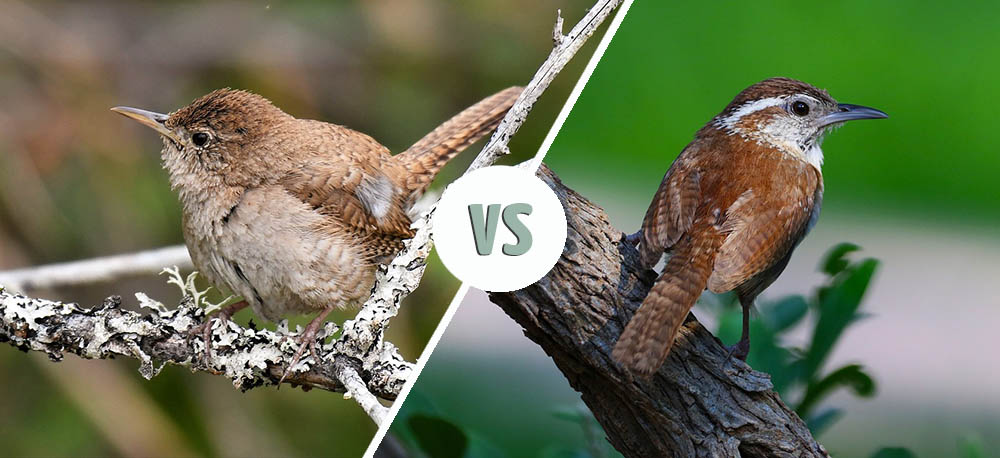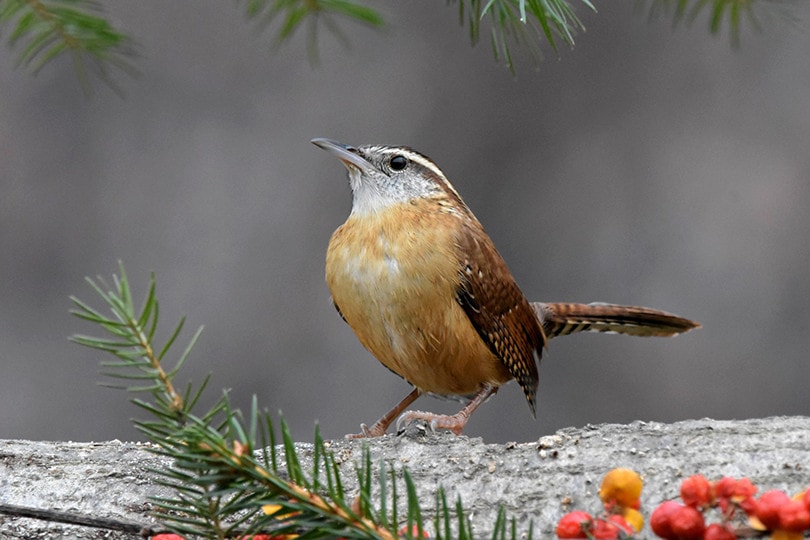House Wren vs. Carolina Wren: How to Tell the Difference
Last Updated on

No matter where you live, you’ve surely come across the common backyard Wren once or twice. These brown passerine birds are part of the New World Troglodytidae family of 88 species. That includes the White-Bellied Wren, Riverside Wren, Monchique Wood Wren, and many more.
The Carolina Wren and House Wren are the two most commonly confused Wrens due to their similar appearance. But, once you learn the differences between these Wrens’ sizes, lifespans, diets, habitats, origins, songs, and behaviors, identifying them can get much easier.
Below are some ways you can differentiate between House Wren and Carolina Wren.

Visual Differences

At a Glance
- Origin: Canada to South America
- Size: 11–13 cm
- Lifespan: 7 years
- Domesticated?: No
- Origin: Canada to South America
- Size: 12–14 cm
- Lifespan: 6 years
- Domesticated?: No
House Wren Overview

House Wrens are small brown songbirds that migrate from Canada to southernmost South America. They are the most commonly occurring bird in the US. The species has many subspecies, such as the Southern House Wren, Northern House Wren, Brown-Throated House Wren, etc.
They also live in Grenada, St. Lucia, Dominica, and Cozumel Island. House Wrens make homes in open forests, grasslands, forest edges, trees, farmyards, backyards, and city parks. In the winter, they opt for more secretive places, such as thickets, hedgerows, and brushy tangles.
Characteristics & Appearance
The adult House Wren has a plain brown appearance, featuring a thin bill, short tail, and pale throat. You may also notice dark barring on its wings, creating a faded checkered contrast. Those found in Southeastern Arizona and the mountains of Arizona have a warmer appearance. Meanwhile, the Northern species has an indistinct eyebrow stripe.
House Wrens on Cozumel Island have white underbellies and brown upper parts. Contrastingly, those in Dominica are a uniform, rich, reddish-brown shade. As for their behavior, their characteristics are energetic and bubbly, as you may find them hopping in tangles and low branches.
They’ll pause and deliver their cheerful, trilling song every so often. Also, their cinnamon-buff throat area and distinct buffy eyebrow set them apart from other Wren species.

Uses
House Wrens have various uses, such as removing pests in your backyard. Their diet consists mainly of spiders, earwigs, caterpillars, and beetles. They may also feed on leafhoppers, flies, springtails, and more.
So, if you want to remove any of these pests from your backyard, you can follow certain tactics to attract House Wrens. The presence of these insects may be enough to attract House Wrens to your backyard. But you may expedite their arrival with the help of mealworms and plenty of water.
But it’s worth noting that these birds are aggressive and territorial, so it’s best to take a professional’s help while attracting them.

Carolina Wren Overview

Carolina Wrens are small songbirds residing in the Eastern half of the US and Southern Ontario, Canada. You may also find this bird in the extreme Northeast of Mexico. However, in the winter, they prefer to stay in Southern areas.
This bird has several subspecies, including the Northeastern Mexican Carolina Wren, Lomita Carolina Wren, and Southeast Canadian Carolina Wren. The Burleigh’s Carolina Wren is found on offshore islands off the Mississippi coast.
They prefer to reside in one area throughout the year, only dispersing in harsh winters. Their permanent breeding ranges include Eastern Nebraska, Southern Michigan, Southeast Ontario, New England states, and Mexican states.
Carolina Wrens make homes in dense covers such as forests, suburban areas, forest edges, backyard brush piles, forest ravines, and densely wooded areas.
Characteristics & Appearance
The adult Carolina Wren has reddish-brown upperparts and buffy underbellies. They also feature a white throat, eyebrow, and a thin bill. You’ll also note dark barring on its tail and wings. In Southern Texas and Northeastern Mexico, its subspecies have brighter colors and faint barring on their back.
Carolina Wrens in Southern Mexico and Central America have cold-brown upper parts and a fluffy, white underbelly. At the same time, the Florida population is large and stout and has a deeply colored underbelly.
You may find this bird creeping around vegetated areas in search of food, cocking its tail upwards as it forages. Carolina Wrens defend their territories by constantly singing as a sign of scolding intruders.

Uses
Carolina Wrens feed on caterpillars, true bugs, crickets, beetles, and millipedes. They may also eat snails, spiders, grasshoppers, and other insects. They also use their long, sharp bills to pull apart and eat large bugs. By attracting these birds, you may be able to reduce the pest population in your backyard.
Carolina Wrens also often catch lizards and tree frogs, further protecting your plants. Since these birds are very aggressive and territorial, they do not appreciate other birds in their habitat and scare them away with constant singing. This way, these birds may help rid your backyard of unnecessary hummingbirds.
However, if you’re growing small fruits or berries in your backyard, the Carolina Wren may feed on them too. It’s also worth noting that all Wrens are aggressive and antisocial, which is why it’s best to use a professional’s help.
You may attract them with suet feeders, peanuts, sunflower seeds, peanut butter, other nuts, mealworms, and plenty of water.
What Are the Differences Between the House Wren and Carolina Wren?
It’s easy to confuse a Carolina Wren for a House Wren as they are both small brown songbirds from the Wren family. But these birds have many differences you might not notice at first glance.
For example, the House Wren is smaller than the Carolina Wren, but only by 2–3 centimeters. You’re also much likelier to spot a House Wren in your backyard since it’s the most commonly occurring Wren in the US. But since its diet consists mainly of insects, you won’t be able to attract it with a suet feeder as you would attract a Carolina Wren.
The best way to differentiate a Carolina Wren from a House Wren is with its distinctive white eyebrow, beige in some cases. Its body is also much larger and chunkier, featuring livelier colors. In addition, House Wrens have longer tails and a longer lifespan.
If you’re paying attention, it’s surprisingly easy to detect the differences between these two Wrens. But, of course, the easiest way to do so is with their song.
The House Wren has a long, jumbled, and bubbly song, featuring abrupt churrs and scolds and making up 12–16 syllables. Their calls include a variety of churrs, scolds, chatters, and rattles. Meanwhile, the Carolina Wren has a quick, repetitive, and whistled song, consisting of up to 15 “teakettle” and “Germany” sounds. Their calls consist of cheers, chatters, and rasps.

Conclusion: Which Breed Is Right for You?
Now that you know the difference between the two most common Wrens, you can identify both species instantly. You can even attract the Carolina Wren and House Wren to your backyard with the right precautions and feed.
However, be cautious with your procedures as these birds can be highly aggressive and antisocial.
Featured Image Credit: (L) Nature-Pix, Pixabay | (R) George, Pixabay
About the Author Jeff Weishaupt
Jeff is a tech professional by day, writer, and amateur photographer by night. He's had the privilege of leading software teams for startups to the Fortune 100 over the past two decades. He currently works in the data privacy space. Jeff's amateur photography interests started in 2008 when he got his first DSLR camera, the Canon Rebel. Since then, he's taken tens of thousands of photos. His favorite handheld camera these days is his Google Pixel 6 XL. He loves taking photos of nature and his kids. In 2016, he bought his first drone, the Mavic Pro. Taking photos from the air is an amazing perspective, and he loves to take his drone while traveling.
Related Articles:
Holy Stone Drone Review of 2024 – Pros, Cons, and Verdict
Ultraviolet Light vs Black Light: What’s the Difference?
Light Waves vs. Sound Waves: The Key Differences
Infrared vs. Thermal Cameras: How Are They Different?
Far Infrared vs Near Infrared: What’s The Difference?
Mottled Duck vs. Mallard vs. Black Duck: What’s the Difference?
Shutter Speed vs Frame Rate: Pros, Cons, & Difference
Oriole vs Goldfinch: How to Tell the Difference
